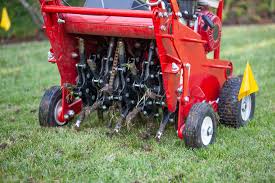Aeration
A lush, green lawn is often the pride of any homeowner. While some may think that regular mowing and watering are the keys to a healthy yard, there’s another crucial maintenance step that can make a world of difference: lawn aeration. This simple yet effective process involves perforating the soil with holes to allow air, water, and nutrients to penetrate down to the grassroots. Let’s explore the many benefits of aerating your lawn.
1. Aerating Improves Soil Structure
Over time, soil can become compacted due to foot traffic, lawn equipment, and natural settling. Compacted soil restricts root growth and limits the availability of essential nutrients and water. Aeration alleviates this problem by creating space in the soil, allowing it to breathe and improve its structure. This helps create a more favorable environment for grass roots to thrive.
2. Aerating Enhances Nutrient Absorption
When soil is compacted, it becomes challenging for nutrients to reach the roots of your grass. Aeration helps to break up that compacted layer, allowing better absorption of fertilizers and organic matter. By aerating your lawn, you ensure that nutrients can penetrate deeper into the soil, promoting healthier grass growth.
3. Aeration Increases Water Infiltration
Heavy rainfall or frequent watering can lead to standing water on your lawn if the soil is compacted. Aeration helps to improve water infiltration, allowing moisture to reach the roots instead of running off or pooling on the surface. This is particularly beneficial during dry spells, as it helps retain moisture in the soil.
4. Aeration Promotes Root Growth
Healthy grass relies on a strong root system. Aeration encourages deeper root growth by providing more space for roots to expand. This is especially important for grass types that are prone to shallow root systems. With deeper roots, your lawn becomes more resilient to drought, disease, and pests.
5. Reduces Thatch Buildup
Thatch is a layer of dead grass, roots, and organic matter that can accumulate on the soil surface. While a small amount of thatch can be beneficial, excessive buildup can hinder water and nutrient absorption. Aeration helps to break down thatch by creating openings in the soil, allowing microorganisms to do their job more effectively.
6. Improves Overall Lawn Health
An aerated lawn is a healthier lawn. With better airflow, moisture retention, and nutrient absorption, your grass will be more vibrant and lush. This leads to a more resilient lawn that can better withstand environmental stresses, such as heat and drought.
7. Encourages Microbial Activity
Aeration creates a more hospitable environment for beneficial soil microorganisms. These microbes play a crucial role in breaking down organic matter, enriching the soil, and supporting plant health. A thriving ecosystem beneath your lawn can contribute to its overall vitality.
8. Reduces Soil Erosion
Compacted soil is more prone to erosion, especially during heavy rains. By aerating your lawn, you improve the soil structure and help it retain moisture, which can reduce the risk of erosion. This not only protects your lawn but also helps maintain the landscape around it.
Conclusion
Aerating your lawn is a vital maintenance practice that offers numerous benefits, from improved soil health to enhanced growth and resilience. Whether you choose to aerate yourself or hire a professional, incorporating this practice into your lawn care routine can lead to a greener, healthier yard that you’ll be proud to show off. So, why wait? Get out there and give your lawn the aeration it deserves! Contact Eternal Tree & Landscape for all of your lawn care needs.


Recent Comments